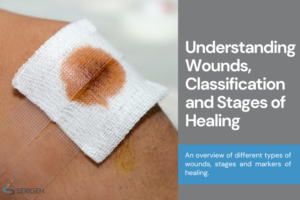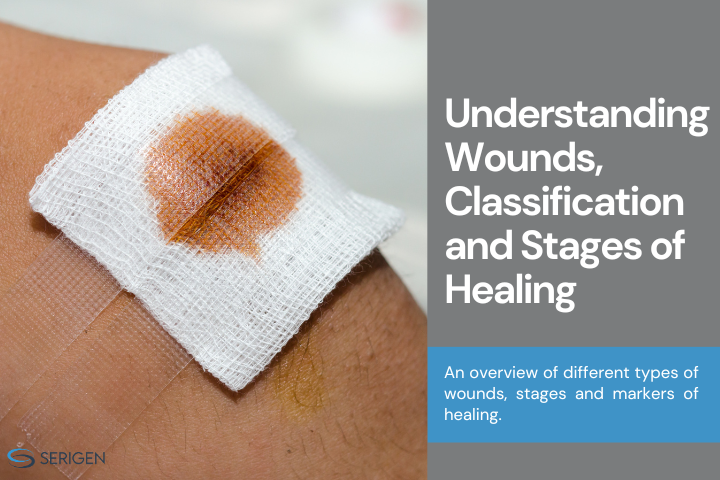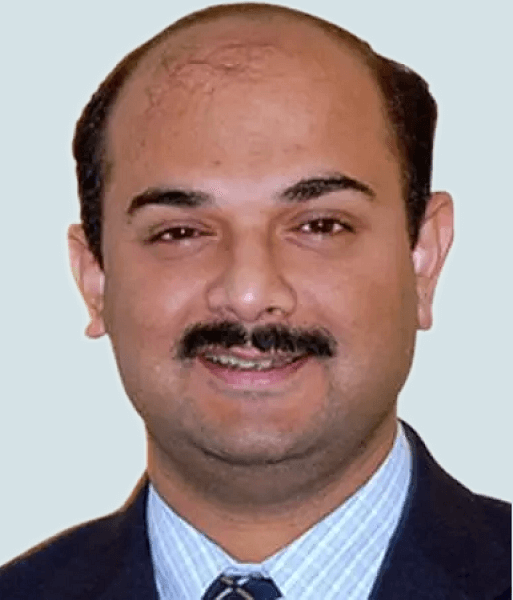Understanding Wounds: Classification and Stages of Wound Healing
What are wounds?
Wounds are injuries to the skin or other body tissues. They can arise from a myriad of causes, including trauma, surgery, or underlying medical conditions. Wounds include cuts, scrapes, scratches, punctured skin, surgery wounds, sutures, stitches etc. Regardless of their origin, all wounds initiate a cascade of events aimed at restoring tissue homeostasis and function.
Proper cleaning and dressing of wounds is essential to prevent infections and additional harm. For minor wounds, cleaning and at-home care may suffice. On the other hand, deep or infected wounds may require professional intervention.
What are the different types of Wounds?
Wounds are classified based on various considerations.
The simplest classification of wounds includes “Open” or “Closed”:
- Closed Wound: In closed wounds, the surface of the skin is unbroken, but the internal tissues may be damaged.
- Open Wounds: In this case, the skin is split or cracked and the underlying tissues are exposed.
Wounds can also be visually classified based on their colour. Visual classification of wounds segregates them into 3 subtypes:
1. Black wounds: They are infected or necrotic and turn black due to lack of blood flow or other factors. Debridement (removal of affected tissue) is usually required. These wounds appear dry. The risk of bacterial infection is high.
2. Yellow wounds: These wounds have a yellowish appearance due to the presence of fibrin, a protein involved in the blood clotting process. They are moist and sloughy. The risk of bacterial infections is high. Cleansing and debridement of such wounds is necessary.
3. Red wounds: These are clean wounds. There is granulation tissue formation. The area may be swollen, soft, moist, bumpy and red in colour.
Furthermore, wounds can also be classified as “Acute” or “Chronic”:
- Acute wounds: An acute wound is a sudden or fresh injury to the skin. It is defined as a wound that has yet to progress through the sequential stages of wound healing. It can be caused due to an incision or trauma and heals in a timely and orderly manner. These wounds can appear anywhere on the body. They include deep cuts, scratches, surgical wounds, and traumatic wounds. These are less complicated wounds and can heal within a span of 1-4 weeks. However, acute wounds can turn into chronic wounds without proper care.
- Chronic wounds: Chronic wounds do not heal in an orderly set of stages and in a predictable amount of time. Wounds that do not heal within three months are often considered to be chronic. Chronic wounds tend to remain in the inflammatory stage for long durations, and may never heal or take years to heal. These wounds mainly include Pressure ulcers, Arterial ulcers, Venous ulcers and Diabetic ulcers.
Acute and Chronic wounds are further classified into two types:
- Exuding wounds (wounds that produce some amount of exudate)
- Non-exuding wounds (typically dry wounds)
Both Acute and Chronic wounds pose different challenges. Acute wounds need more attention to controlling blood loss and reducing the chances of infections. Chronic wounds need management strategies to get them into the healing phase.
The Phases of Wound Healing
Wound healing is a natural physiological reaction to tissue injury. It’s a complex biological process that involves a series of precisely orchestrated stages aimed at restoring tissue integrity and function. Each stage is characterised by the expression of a set of markers. The 4 stages and their characteristic molecular expression are described below:
1. Hemostasis: Hemostasis is the body’s immediate response to injury. When blood vessels are damaged, platelets rush to the site and aggregate to form a temporary plug, halting bleeding. Concurrently, blood vessel constriction and clotting factor activation further reinforce the hemostatic seal, laying the foundation for subsequent repair processes.
2. Inflammation: Inflammation occurs within the first 24 hours after injury and can last for up to 2 weeks in normal wounds and significantly longer in chronic non-healing wounds. Inflammation heralds the arrival of immune cells through secretion of cytokines such as TNF-ɑ, IL-1β, IL-6 etc. to the wound site, marking the second stage of wound healing. Neutrophils, macrophages, and other immune players orchestrate a multifaceted response, eliminating pathogens, clearing cellular debris, and releasing signalling molecules crucial for tissue repair. While inflammation is essential for initiating healing, dysregulated or prolonged inflammation can impede the process, underscoring the delicate balance required for optimal wound resolution.
3. Proliferation: As inflammation subsides, the proliferation phase commences, characterised by the proliferation and migration of various cell types essential for tissue regeneration. SDF-1⍺-CXCR-4-VEGFR-2 axis plays a pivotal role in migration and proliferation of these cells. Fibroblasts and endothelial cells emerge as pivotal players, synthesising extracellular matrix components like collagen (Col-1) to rebuild the structural framework of the wounded area. Meanwhile, endothelial cells sprout new blood vessels, ensuring adequate nutrient and oxygen delivery to support cellular activities. Expression of markers such as Ang-1, CD-31 and VE-Cadherin is the signature of angiogenesis (new blood vessel formation).
4. Remodelling: The final act of wound healing, remodelling, focuses on refining and optimising the newly formed tissue. Collagen fibres undergo realignment and cross-linking, imparting strength and resilience to the healing wound. Excess matrix components are gradually degraded, and the wound undergoes contraction, reducing its size and restoring functional integrity. Remodelling phase is regulated balanced expression of matrix metalloproteinases (eg. MMP-9) and their inhibitors TIMPs. Remarkably, remodelling can continue for months or even years after the initial injury, culminating in scar maturation and tissue stabilisation.
How does Serigen offer Accelerated Wound Healing Solutions for a Wide Variety of Wounds?
At Serigen, we have developed advanced silk-based wound dressings that expedite the healing of even complex wounds. Seriderm® is our non-adherent and absorbent silk-based dressing that offers optimal moisture management at the wound environment by a) absorbing exudate and b) maintaining ideal moisture levels for faster healing. Additionally, Seriderm’s novel silk-based composition improves vasculature and granulation tissue formation. With these unique advantages, Seriderm® promotes faster healing of a wide range of wounds, including chronic, non-healing wounds such as diabetic ulcers, second-degree burns, pressure ulcers, and surgical wounds. Additionally, our new product, Seriderm® Ag combines the healing power of Seriderm® with the antimicrobial action of Silver ions for the optimal management of infected or infection-prone wounds.
Our cutting-edge wound dressings simplify wound management and improve wound care outcomes for diverse patient populations, as substantiated by studies and clinical use cases. Hence, Serigen’s revolutionary wound management solutions are setting new standards for efficiency and effectiveness in wound healing!
References
- https://medlineplus.gov/woundsandinjuries.html#:~:text=Wounds%20are%20injuries%20that%20break,is%20important%20to%20clean%20them.
- https://www.ncbi.nlm.nih.gov/books/NBK554456/
- https://www.ncbi.nlm.nih.gov/pmc/articles/PMC5339604/#:~:text=A%20chronic%20wound%20is%20a,heal%20or%20may%20take%20years.
- https://my.clevelandclinic.org/health/symptoms/21999-hemostasis
- https://www.sciencedirect.com/topics/engineering/inflammatory-phase#:~:text=Biomedical%20Engineering%2C%202019-,Proliferation%20Phase,to%20produce%20a%20new%20ECM.
- https://www.physio-pedia.com/Wound_Healing

Author Bio –
Kartiki Kane is a Research Associate at Serigen Mediproducts. She holds a degree in Microbiology and Biodiversity from MES Abasaheb Garware College, Pune and has 3 years of professional experience in tissue engineering and animal cell culture.

What are wounds?
Wounds are injuries to the skin or other body tissues. They can arise from a myriad of causes, including trauma, surgery, or underlying medical conditions. Wounds include cuts, scrapes, scratches, punctured skin, surgery wounds, sutures, stitches etc. Regardless of their origin, all wounds initiate a cascade of events aimed at restoring tissue homeostasis and function.
Proper cleaning and dressing of wounds is essential to prevent infections and additional harm. For minor wounds, cleaning and at-home care may suffice. On the other hand, deep or infected wounds may require professional intervention.
What are the different types of Wounds?
Wounds are classified based on various considerations.
The simplest classification of wounds includes “Open” or “Closed”:
- Closed Wound: In closed wounds, the surface of the skin is unbroken, but the internal tissues may be damaged.
- Open Wounds: In this case, the skin is split or cracked and the underlying tissues are exposed.
Wounds can also be visually classified based on their colour. Visual classification of wounds segregates them into 3 subtypes:
1. Black wounds: They are infected or necrotic and turn black due to lack of blood flow or other factors. Debridement (removal of affected tissue) is usually required. These wounds appear dry. The risk of bacterial infection is high.
2. Yellow wounds: These wounds have a yellowish appearance due to the presence of fibrin, a protein involved in the blood clotting process. They are moist and sloughy. The risk of bacterial infections is high. Cleansing and debridement of such wounds is necessary.
3. Red wounds: These are clean wounds. There is granulation tissue formation. The area may be swollen, soft, moist, bumpy and red in colour.
Furthermore, wounds can also be classified as “Acute” or “Chronic”:
- Acute wounds: An acute wound is a sudden or fresh injury to the skin. It is defined as a wound that has yet to progress through the sequential stages of wound healing. It can be caused due to an incision or trauma and heals in a timely and orderly manner. These wounds can appear anywhere on the body. They include deep cuts, scratches, surgical wounds, and traumatic wounds. These are less complicated wounds and can heal within a span of 1-4 weeks. However, acute wounds can turn into chronic wounds without proper care.
- Chronic wounds: Chronic wounds do not heal in an orderly set of stages and in a predictable amount of time. Wounds that do not heal within three months are often considered to be chronic. Chronic wounds tend to remain in the inflammatory stage for long durations, and may never heal or take years to heal. These wounds mainly include Pressure ulcers, Arterial ulcers, Venous ulcers and Diabetic ulcers.
Acute and Chronic wounds are further classified into two types:
- Exuding wounds (wounds that produce some amount of exudate)
- Non-exuding wounds (typically dry wounds)
Both Acute and Chronic wounds pose different challenges. Acute wounds need more attention to controlling blood loss and reducing the chances of infections. Chronic wounds need management strategies to get them into the healing phase.
The Phases of Wound Healing
Wound healing is a natural physiological reaction to tissue injury. It’s a complex biological process that involves a series of precisely orchestrated stages aimed at restoring tissue integrity and function. Each stage is characterised by the expression of a set of markers. The 4 stages and their characteristic molecular expression are described below:
1. Hemostasis: Hemostasis is the body’s immediate response to injury. When blood vessels are damaged, platelets rush to the site and aggregate to form a temporary plug, halting bleeding. Concurrently, blood vessel constriction and clotting factor activation further reinforce the hemostatic seal, laying the foundation for subsequent repair processes.
2. Inflammation: Inflammation occurs within the first 24 hours after injury and can last for up to 2 weeks in normal wounds and significantly longer in chronic non-healing wounds. Inflammation heralds the arrival of immune cells through secretion of cytokines such as TNF-ɑ, IL-1β, IL-6 etc. to the wound site, marking the second stage of wound healing. Neutrophils, macrophages, and other immune players orchestrate a multifaceted response, eliminating pathogens, clearing cellular debris, and releasing signalling molecules crucial for tissue repair. While inflammation is essential for initiating healing, dysregulated or prolonged inflammation can impede the process, underscoring the delicate balance required for optimal wound resolution.
3. Proliferation: As inflammation subsides, the proliferation phase commences, characterised by the proliferation and migration of various cell types essential for tissue regeneration. SDF-1⍺-CXCR-4-VEGFR-2 axis plays a pivotal role in migration and proliferation of these cells. Fibroblasts and endothelial cells emerge as pivotal players, synthesising extracellular matrix components like collagen (Col-1) to rebuild the structural framework of the wounded area. Meanwhile, endothelial cells sprout new blood vessels, ensuring adequate nutrient and oxygen delivery to support cellular activities. Expression of markers such as Ang-1, CD-31 and VE-Cadherin is the signature of angiogenesis (new blood vessel formation).
4. Remodelling: The final act of wound healing, remodelling, focuses on refining and optimising the newly formed tissue. Collagen fibres undergo realignment and cross-linking, imparting strength and resilience to the healing wound. Excess matrix components are gradually degraded, and the wound undergoes contraction, reducing its size and restoring functional integrity. Remodelling phase is regulated balanced expression of matrix metalloproteinases (eg. MMP-9) and their inhibitors TIMPs. Remarkably, remodelling can continue for months or even years after the initial injury, culminating in scar maturation and tissue stabilisation.
How does Serigen offer Accelerated Wound Healing Solutions for a Wide Variety of Wounds?
At Serigen, we have developed advanced silk-based wound dressings that expedite the healing of even complex wounds. Seriderm® is our non-adherent and absorbent silk-based dressing that offers optimal moisture management at the wound environment by a) absorbing exudate and b) maintaining ideal moisture levels for faster healing. Additionally, Seriderm’s novel silk-based composition improves vasculature and granulation tissue formation. With these unique advantages, Seriderm® promotes faster healing of a wide range of wounds, including chronic, non-healing wounds such as diabetic ulcers, second-degree burns, pressure ulcers, and surgical wounds. Additionally, our new product, Seriderm® Ag combines the healing power of Seriderm® with the antimicrobial action of Silver ions for the optimal management of infected or infection-prone wounds.
Our cutting-edge wound dressings simplify wound management and improve wound care outcomes for diverse patient populations, as substantiated by studies and clinical use cases. Hence, Serigen’s revolutionary wound management solutions are setting new standards for efficiency and effectiveness in wound healing!
References
- https://medlineplus.gov/woundsandinjuries.html#:~:text=Wounds%20are%20injuries%20that%20break,is%20important%20to%20clean%20them.
- https://www.ncbi.nlm.nih.gov/books/NBK554456/
- https://www.ncbi.nlm.nih.gov/pmc/articles/PMC5339604/#:~:text=A%20chronic%20wound%20is%20a,heal%20or%20may%20take%20years.
- https://my.clevelandclinic.org/health/symptoms/21999-hemostasis
- https://www.sciencedirect.com/topics/engineering/inflammatory-phase#:~:text=Biomedical%20Engineering%2C%202019-,Proliferation%20Phase,to%20produce%20a%20new%20ECM.
- https://www.physio-pedia.com/Wound_Healing

Author Bio –
Kartiki Kane is a Research Associate at Serigen Mediproducts. She holds a degree in Microbiology and Biodiversity from MES Abasaheb Garware College, Pune and has 3 years of professional experience in tissue engineering and animal cell culture.











